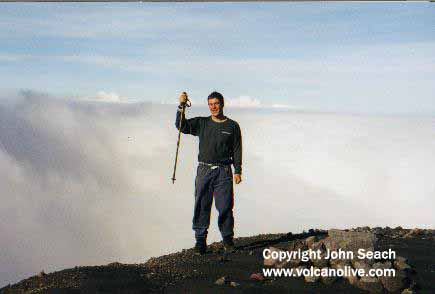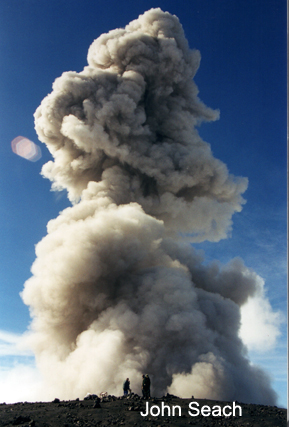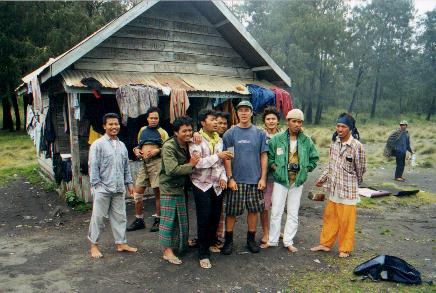Volcano Live
volcanolive.com
Semeru Volcano | John Seach

East Java, Indonesia
8.10 S, 112.92 E
summit elevation 3676 m
Stratovolcano
Semeru volcano is located in east
Java, Indonesia. It is one of the most active volcanoes in
Indonesia. Typically eruptions occur every 20-30 minutes, with ash
emissions to 100-400 m above the crater, and projectiles ejected
onto the crater rim. The present activity center is at Jonggring
Seloko, a crater that appears in the southeast part of Mahameru, and
it is separated by a narrow saddle.
Large
eruptions are often followed by generation of pyroclastic flows.
Semeru volcano is the highest in Java and one of the most active
volcanoes in the world. Semeru volcano has been the site of numerous
deaths.
Semeru volcano photos by John Seach

Semeru volcano

John Seach at summit of Semeru volcano.
Warning: the summit region of Semeru is very
dangerous due to explosive activity.

Summit eruption Semeru volcano 2000

John Seach and climbers at 2700 m on the Northern approach to
Semeru from Ranu Pani village.
Hazard Zone at Semeru Volcano
The hazard zone at Semeru volcano is a 5 km radous from the active
crater. Along some valleys the hazard zone extends 12 km. Lumajang
city lies in a lahar prone zone.
2025 Eruption
A large explosive eruption occurred on 19 November 2025. Ash emissions reached an altitude of 54,000 ft. Pyroclastic flows were reported to a distance of 8.5 km from the crater. The alert statuis was raised to level 3 (Siaga).
2022 Eruption
A large explosive eruption occurred on 4 December 2022. Ash emissions reached an altitude of 50,000 ft. Pyroclastic flows extended 13 km S and SE. The alert status was raised to maximum level 4.
2021 Eruption
A large eruption occurred at Semeru volcano on 4 December 2021. Ash emissions reached 50,000 ft altitude. Pyroclastic flows approached populated areas. There were 13 fatalities from the eruption.
2020 Activity
A 3 minute 50 second eruption occurred on 18 January 2020. Ash emissions reached 15,000 ft altitude (1300 ft above crater). Exclusion zone is 1 km radius from crater, and 4 km on SSE flank.
2018 Activity
Possible ash emissions occurred at Semeru volcano in august 2018,
indicating ongoing activity.
2011-2012 Activity
Eruptions were observed at the volcano on 9,14, and 17 June 2011.
Activity at Semeru resumed at the end of December 2011. Between 29th
December 2011 and 15th January 2012 there were eight explosions at
Jonggring Seloko crater, sending ash up to 600 m high. Incandescent
fallout was observed 200 m radius from the crater. On 2nd February
2012 a pyroclastic flow reached 2.5 km from the crater. The alert
status at Semeru volcano was raised to Level 3 (out of a maximum 4)
on 3rd February 2012. A 4 km exclusion zone was placed on the SE
slopes of the volcano where pyroclastic flows occur. Climbers were
advised to remain at least 1 km from Jonggring Seloko crater.
2009 Eruptions
Increased activity has been reported at Semeru volcano in
Indonesia. Between 6th February and
4th March 2009 there were 873 explosion earthquakes registered,
with an average of 34 events per day. On 5th March there was one
period of tremor recorded. On 6th March one episode of tremor
was recorded accompanied by booming sounds which were heard at
Semeru observatory. On 6th March at 10:28 hr a booming noise was
heard while the summit was covered in cloud. Semeru is at level
2 alert (Waspada) out of a maximum of 4. Explosions occur at an
interval of 20-30 minutes, with ash emissions 100-400 m above
Jonggring Seloko crater. So far the current eruptions have not
been accompanied by pyroclastic flows, but this remains a
danger. Areas which may be affected by pyroclastic flows include
inhabited areas of Rowo Baung, Supit, Pronojiwo, Urip, and
Umbulandi Urang Supit. Rowo Baung and Supit are the nearest
villages to the eruptive centre, 9 km from the peak of Gunung
Semeru. There is a potential threat to sand mining activities at
Supit and Rowo Baung. Recommendations from the Indonesian Centre
of Volcanology and Geology are that people avoid the area 4 km
SE of the active crater at Semeru due to the threat of
pyroclastic flows. People are advised not to climb to the summit
peak (Mahameru). Residents should prepare for possible ashfall.
Aircraft should beware of explosion hazards, and ash emissions
from Semeru.
July 2000 Summit Fatalities
A scientific team was caught in an eruption at the summit of Semeru
on 27th July 2000. At approximately 0706 hr an explosion resulted in
two deaths and injuries to five other volcanologists near the NE rim
of the active summit crater Jonggring Seloko. Members of the group
had approached the rim of the active crater which is always
dangerous. The two fatalities were from Volcanological Survey of
Indonesia. Injuries were sustained by climbers from Semeru Volcano
Observatory, Hebrew University in Israel, University of Pittsburgh,
the Smithsonian Institution. This was the second fatal field trip
after an IAVCEI meeting. The first was in Galeras, Colombia in 1993.
2000 Expedition by John Seach
John Seach made observations during a 3-hour summit stay on 2 May
2000. During the climb from Ranu Pani village in the N, ash deposits
were observed to cover vegetation at a distance of 10 km from the
volcano. The bottom third of the cone was vegetated, and zones of
mass-wasting had sliced away 20- m-wide sections of forest. The top
two-thirds of the cone consisted of ash, cinders, and blocks up to
1.5 m in diameter. There were areas of deep erosion and the risk of
rockfalls posed a hazard to climbers. The summit area (Mahameru) lay
covered by ash and baseball-sized blocks with a density of 50/m2. A
20-m-wide, 60-m-deep, W-sloping valley separated Mahameru from the
active Jonggring Seloko crater, but they are joined by a ridge. The
highest N rim of the crater was approximately 30 m below the summit
peak. A 2-m-diameter block was located 15 m below the summit on the
wall of the valley. Between 0725 and 1010, 13 eruptive events were
observed. During this interval the N rim of Jonggring could not be
approached because of the intermittent rain of blocks falling
outside the crater and into the valley 50 m from the crater. Two
vents produced short-lived Vulcanian eruptions with variable timing
and size. Eruptions commenced with degassing, explosions, or the
sound of breaking rock, followed by falling bombs and brown ash
emission. The explosions were relatively quiet and not accompanied
by groundshaking. Brown ash clouds rose to 600 m above the vent and
drifted SE. The plume detached from the summit before the next
eruption began. Steam emission occurred between eruptions.
1999 Summit Fatalities
Two climbers died near the crater on 2nd September after being
struck by large ejected ballistics. The two men were part of a group
of 17 from Germany. The victims, together with the group leader, had
separated from the group to check the crater when the accident
occurred.
1994 Eruptions
On 3 February lava avalanches and pyroclastic flows from the summit
crater descended SE along the Kembar and Kobokan rivers, reaching
7.5 km and 11.5 km from the summit. Six people were killed and 275
people were evacuated from Sumbersari village.
1981 Eruptions
On 14th May heavy rains created mudflows/landslides which killed 252
persons, left 152 injured and 120 missing. The
location of the landslide was similar to that of 1909.
1957 Debris Flow
A debris flow occurred at Semeru volcano in 1957 which reached
Lumanjang city.
1946 Eruptions
In February 1946 ash rain fell in Malang. on 27th May 1946 a report
from Aneta, Batavia stated "Semeru volcano lately became
active, and ash, stoneblocks and mud were thrown out. A
hundred dwelling houses and about 150 hectares of rice fields were
destroyed, and lahar-floods were caused." Ash fell in Malang.
1941 Eruption
An eruption occurred at the base of Semeru volcano in 1941.
Further reading
Nishimura, T., Iguchi, M., Kawaguchi, R., Hendrasto, M. and Rosadi, U., 2012. Inflations prior to Vulcanian eruptions and gas bursts detected by tilt observations at Semeru Volcano, Indonesia. Bulletin of volcanology, 74(4), pp.903-911.
Siswowidjoyo, S., Sudarsono, U. and Wirakusumah, A.D., 1997. The threat of hazards in the Semeru volcano region in East Java, Indonesia. Journal of Asian Earth Sciences, 15(2-3), pp.185-194.
Doyle, E.E., Cronin, S.J., Cole, S.E. and Thouret, J.C., 2010. The coalescence and organization of lahars at Semeru volcano, Indonesia. Bulletin of volcanology, 72(8), pp.961-970.
Semeru Volcano Eruptions
2014-2025, 2011-2012, 1967-2009, 1950-64, 1946-47, 1946, 1945, 1941-42, 1913, 1912, 1911, 1910-11, 1909-10, 1908, 1907, 1905, 1904, 1903, 1901, 1900, 1899, 1898, 1897, 1896, 1895, 1893-94, 1893, 1892, 1889-91, 1888, 1887, 1886, 1884-85, 1879, 1878, 1877, 1872, 1867, 1865, 1860, 1857, 1856, 1851, 1848, 1845, 1844, 1842, 1838, 1836, 1832, 1830, 1829, 1818.